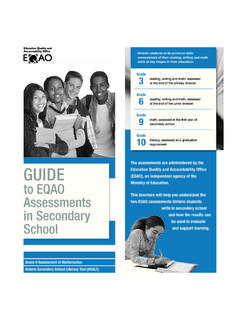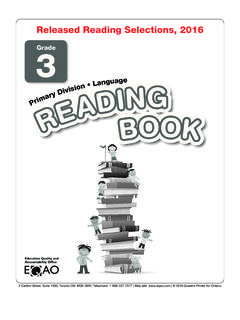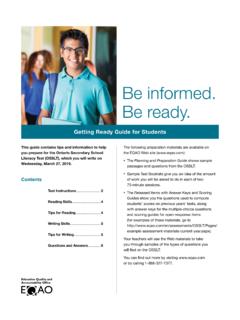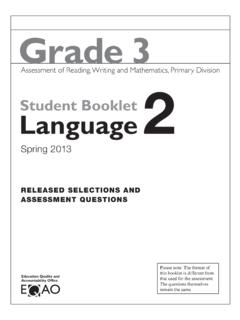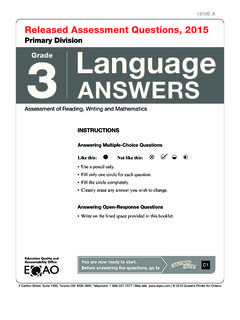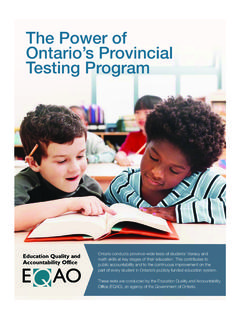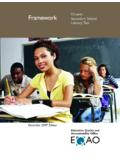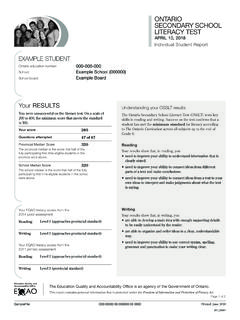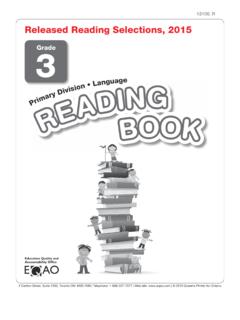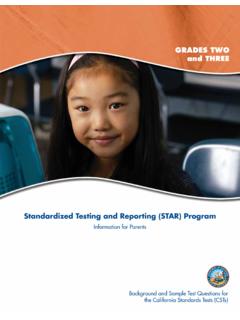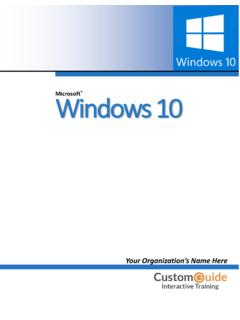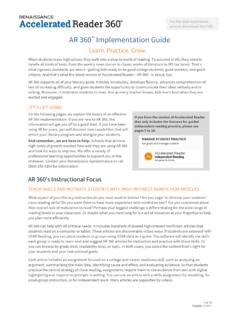Transcription of Planning and Preparation uide - EQAO OQRE
1 Planning and Preparation GuideOntario Secondary School Literacy TestThis guide contains information to help you prepare your students for the Ontario Secondary School Literacy Test (OSSLT).Please visit our Web site, , to access other valuable support documents, including the following: a sample test, with examples of the Question and Answer booklets; previously administered tests, with Student Answer Keys and scoring rubrics, and the OSSLT ..2 What is the OSSLT? ..2 Reading ..3 Reading selections ..3 Types of questions.
2 3 Examples of selections and ..15 Types of questions ..15A. Long-writing tasks ..15B. Short-writing tasks ..18C. Multiple-choice questions (writing) ..19 Teachers Frequently Asked Questions ..21 Students Frequently Asked Questions ..23 Planning and Preparation Guide 2 Ontario Secondary School Literacy TestWhat is the OSSLT?The OSSLT is a provincial test of literacy (reading and writing) skills students have acquired by Grade 10. It is based on the literacy skills expected in The Ontario Curriculum across all subject areas up to the end of Grade 9.
3 Administration Date April 10, 2018 Test Materialsfour test booklets: two Question Booklets and two corresponding Answer Booklets (print version) hours of testing time in totalResultsan Individual Student Report indicating whether the student was successful or unsuccessfulReadingWritingReading selections: information paragraph (225 to 250 words) news report (225 to 250 words) dialogue (225 to 250 words) real-life narrative (550 to 600 words) graphic text (fewer than 150 words)Types of writing tasks and questions: two long-writing tasks news report (one page) series of paragraphs expressing an opinion (two pages) two short-writing tasks (six lines each) multiple-choice questions developing a main idea with supporting details organization of ideas language conventionsTypes of questions.
4 Multiple-choice open-response (six lines each)IntroductionPlanning and Preparation Guide 3 Ontario Secondary School Literacy TestReadingFor the OSSLT, reading is defined as the process through which the reader makes meaning of a variety of written texts as reflected in the expectations in The Ontario Curriculum across all subjects up to the end of Grade 9. The OSSLT s informational, narrative and graphic reading selections focus on three reading skills: understanding explicitly (directly) stated ideas and information.
5 Understanding implicitly (indirectly) stated ideas and information and making connections between information and ideas in a reading selections information paragraph: presents ideas and information on a topic (Example 1) news report: presents information in the form of a news story (Example 2) dialogue: presents a conversation between two or more people (Example 3) real-life narrative: presents an account of a significant time in an individual s life (Example 4) graphic text: presents ideas and information with the help of graphic features, such as diagrams, photographs, drawings, sketches, patterns, timetables, maps, charts or tables (Example 5)Types of questions multiple-choice Each reading text is followed by a number of multiple-choice questions.
6 Students select the best or most correct answer from a list of four options. Note: In this guide, correct answers to multiple-choice questions are indicated by an asterisk(*). written answers The information paragraph, news report and dialogue are followed by one or two open-response questions. Students construct a response based on the reading selection. The length of student responses should be approximately six lines. Note: In this guide, rubrics are not available. However, Item-Specific Rubrics and Sample Student Responses with Annotations from previously administered tests are available on the EQAO Web site, and Preparation Guide 4 Ontario Secondary School Literacy TestExample 1 Information Paragraph Examples of Selections and QuestionsWritten for the selection below and answer the questions in Answer Booklet Reading page 2 CWhen the Ontario government lifted a ban on outdoor clotheslines in April 2008.
7 People wondered why such a ban had ever existed. The controversy over clotheslines reflects conflicting priorities. Drying laundry in the sun and the breeze was common in North America until the boom in owning household appliances and the construction of suburban housing developments in the 1950s and 1960s. At the time, many builders and municipal councils established rules to ensure that new neighbourhoods maintained a uniform and attractive look.
8 The restrictions could relate to paint colour, fences and clotheslines. Older neighbourhoods, built at a time when hanging clothes outside was a necessity, generally escaped similar restrictions. Although clotheslines were often considered old-fashioned and unsightly, more recently, they have become associated with eco-awareness and energy conservation. Electric-dryer use consumes 6% of Ontario s power per year and emits 700 000 tonnes of greenhouse gases.
9 Five electric dryers produce about the same amount of emissions in one year as an average-sized car. Environmentalists are applauding the government s action. Ontario s chief conservation officer said: We re asking people to adopt a culture of conservation in everything they do. This is small but important. I m not requiring everyone to use [clotheslines]. But at least let people have that right. Clotheslines are symbolic of a shift in society s concerns.
10 As one clothesline activist said, If we can t solve a simple thing like hanging two hooks in the backyard, what chance do we have of solving our bigger energy crisis? 5 10 15 Read the selection below and answer the questions in the Answer Booklet. Planning and Preparation Guide 5 Ontario Secondary School Literacy TestInformation Paragraph (cont d)Provide your answers in Answer Booklet Questions1 Why did there used to be a ban on clotheslines?A to increase energy conservation B to sell more household appliancesC to promote the construction of suburban housing D to help neighbourhoods look consistently appealing *2 What is the purpose of the comma in line 7?
